Tofu And Kimchi Bibimbap-Stuffed Pepper Recipe
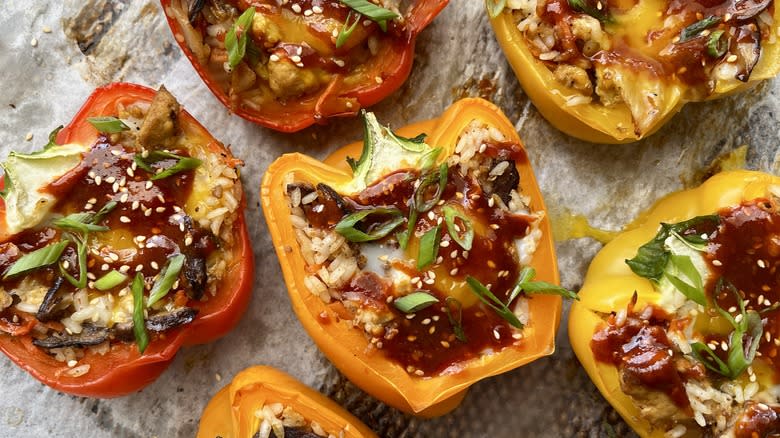
The Korean dish known as bibimbap is traditionally eaten in the form of a layered rice bowl, but here recipe developer Tess Le Moing re-envisions it in stuffed pepper form. "This is a great clean-out-the-fridge-meal — whatever veggie odds and ends you have can go into it," Le Moing explains. Fill your peppers with rice, tofu, carrots, kimchi, and mushrooms per this recipe (or add anything else hanging out in your fridge), and you'll have what she calls "a unique and delicious weeknight meal."
One tip Le Moing has to make the prep work easier for this recipe is to look for four-sided bell peppers. That way "they have a flat foundation when you cut them in half," so they can stand up in the baking pan and on the plate, she says. If your peppers do tip over, though, Le Moing has yet another helpful hint to offer: "I like to serve it in a bowl and cut up the pepper into smaller pieces, then eat it like a rice bowl," she tells us.
Read more: 21 Delicious Ways To Use Up Leftover Rice
Collect The Ingredients For Tofu And Kimchi Bibimbap-Stuffed Peppers
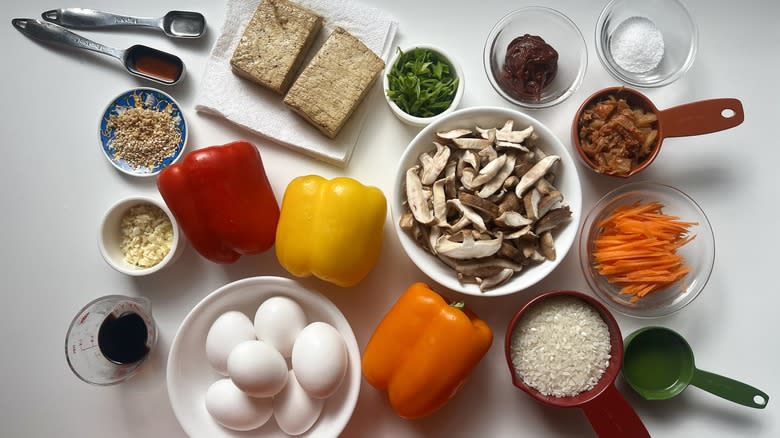
The base of this dish is bell peppers stuffed with rice (Le Moing uses short grain rice), carrots, shiitake mushrooms, tofu, and kimchi and topped with an egg. You'll also need salt and canola oil for cooking, along with scallions for garnish. Le Moing also likes to serve her stuffed peppers with a sauce made from gochujang, sesame oil, soy sauce, rice vinegar, garlic, and sesame seeds.
Step 1: Turn On The Oven
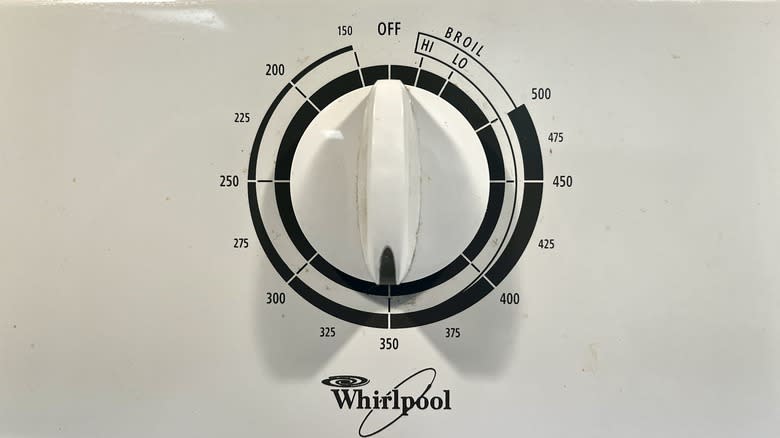
Preheat oven to 350 F.
Step 2: De-Seed The Peppers
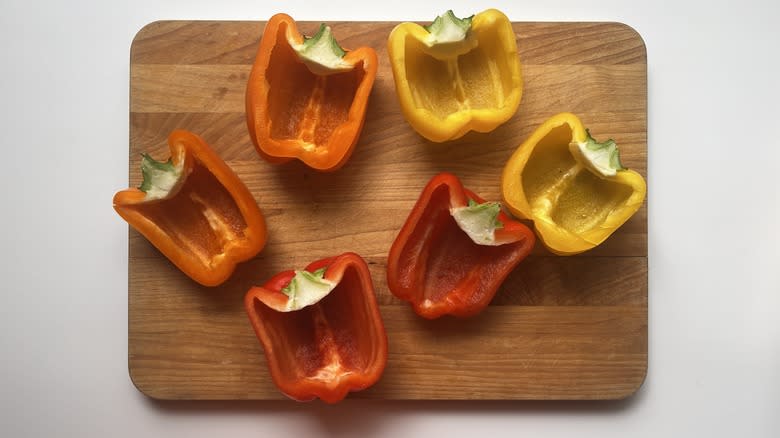
Cut bell peppers in half lengthwise and remove the seeds and membranes.
Step 3: Boil A Pot Of Salted Water
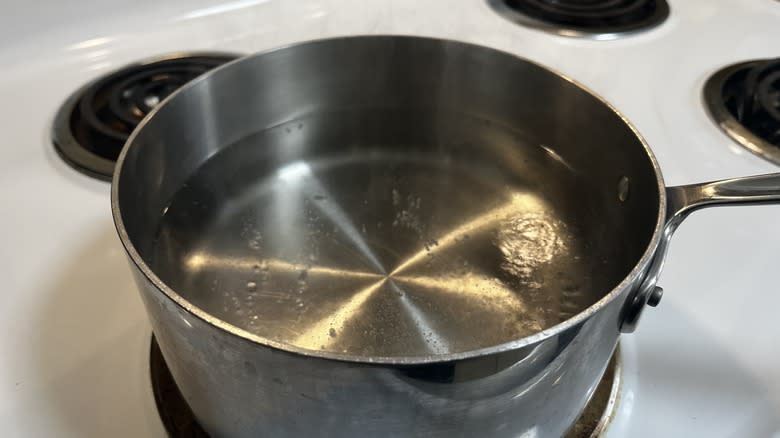
Add 2 quarts water and 1 ½ teaspoons salt to a medium pot over high heat, and bring to a boil.
Step 4: Precook The Peppers In The Boiling Water
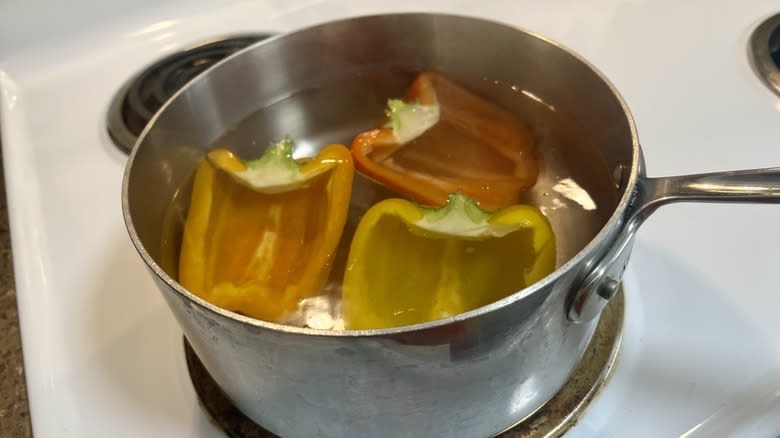
Boil peppers in batches until they begin to soften, about 3-4 minutes.
Step 5: Transfer The Peppers To A Sheet Pan
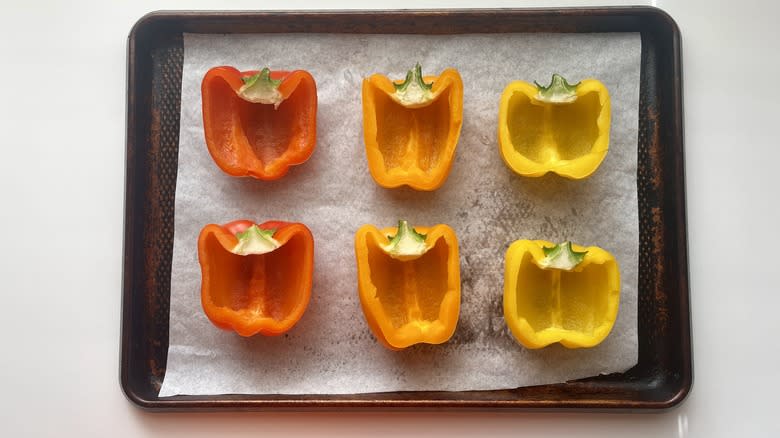
Using tongs or a slotted spoon, remove peppers from the pot, shake off any excess water, and place cut-side up on a parchment-lined baking sheet.
Step 6: Cook The Rice In The Same Water
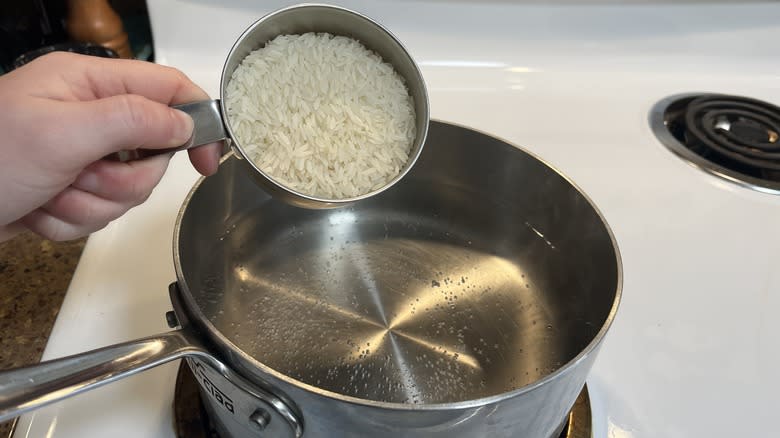
Return water to a boil. Add rice and cook, stirring occasionally, until tender, about 12 minutes.
Step 7: Remove The Rice From The Pot
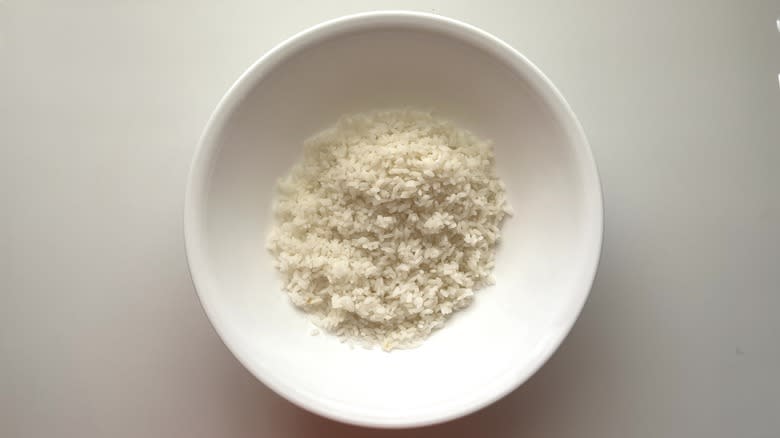
Drain rice, transfer to a large bowl, and set aside.
Step 8: Add Oil To A Hot Frying Pan
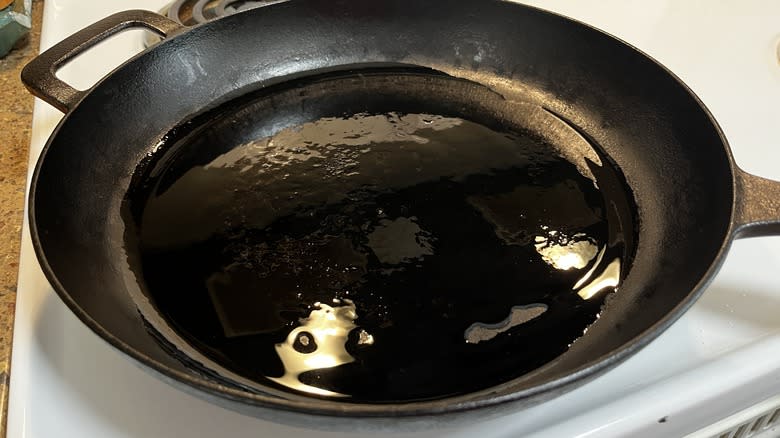
Place a 12-inch, heavy-bottomed skillet over medium heat. Once hot, add 1 tablespoon oil and swirl to coat.
Step 9: Fry The Carrots
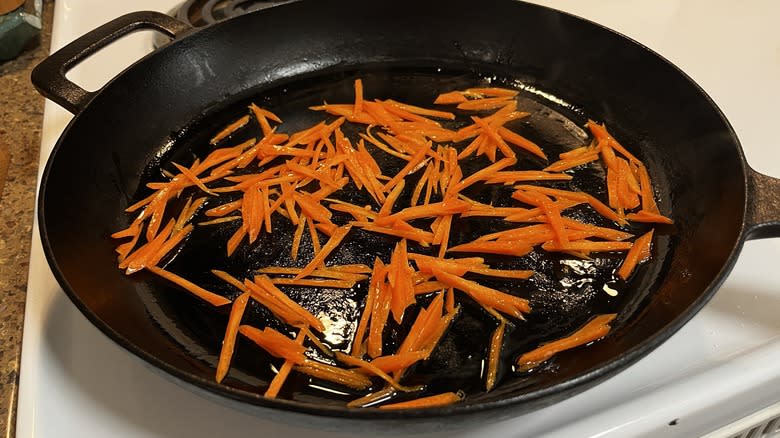
Add carrots and cook, stirring often, until they begin to soften, about 4 minutes.
Step 10: Combine The Cooked Carrots And Rice
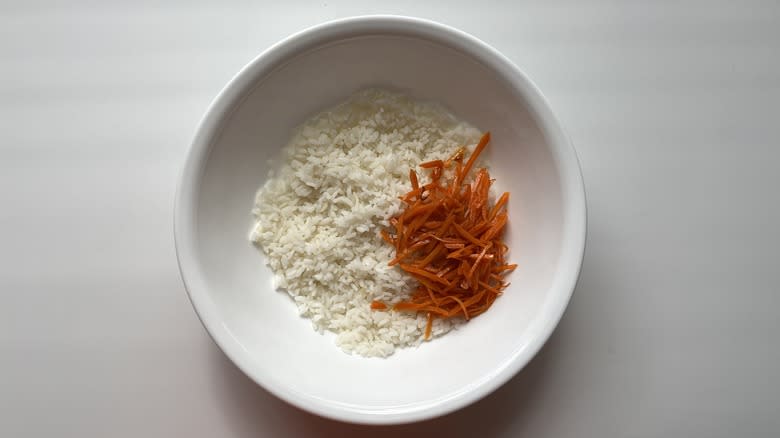
Transfer carrots to the bowl with the rice.
Step 11: Fry The Mushrooms And Garlic
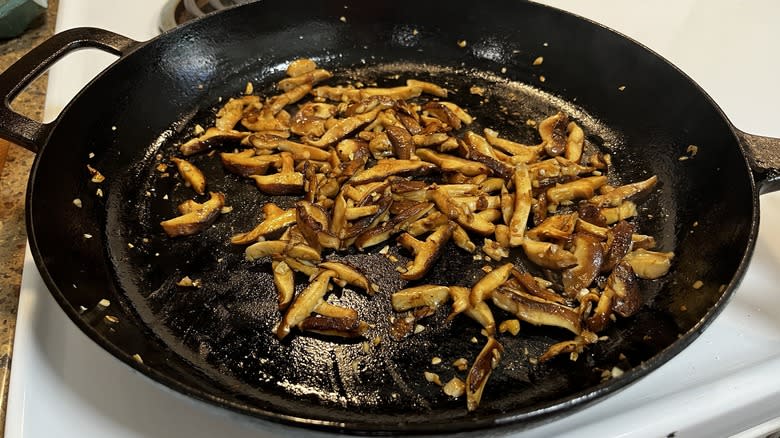
Add 1 more tablespoon oil, along with the mushrooms and garlic, and cook, stirring often, until they begin to soften, about 5 minutes. Stir in the soy sauce.
Step 12: Add The Mushrooms To The Carrots And Rice
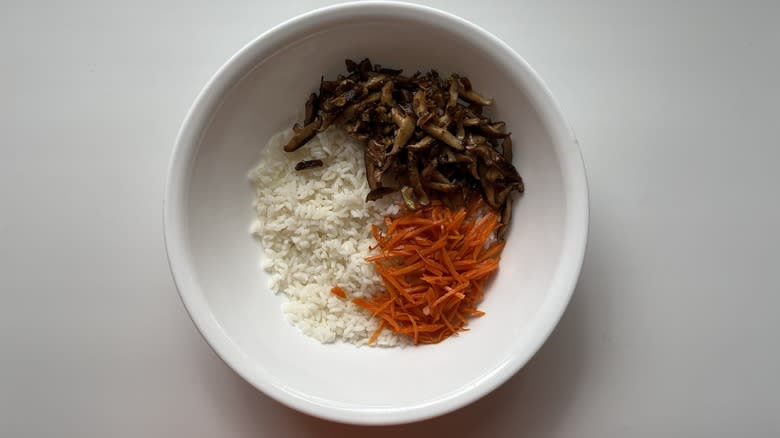
Transfer mushroom mixture to the bowl with the rice.
Step 13: Brown The Tofu
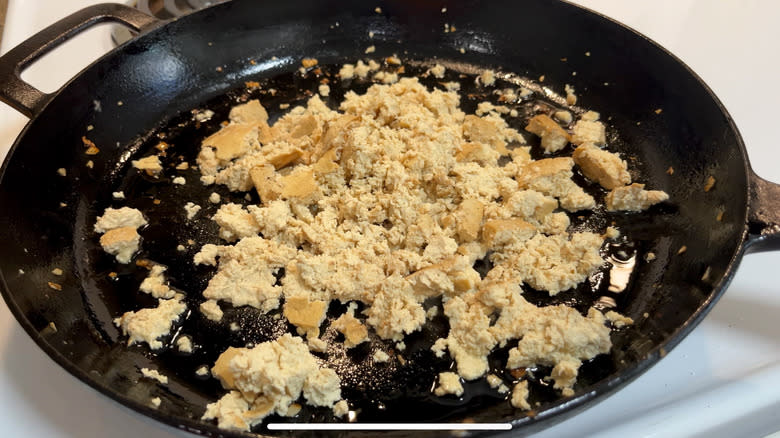
Add remaining 1 tablespoon oil to the pan, crumble in the tofu, and saute until lightly browned and warmed through.
Step 14: Put The Tofu And Kimchi In The Bowl With The Vegetable-Rice Mixture
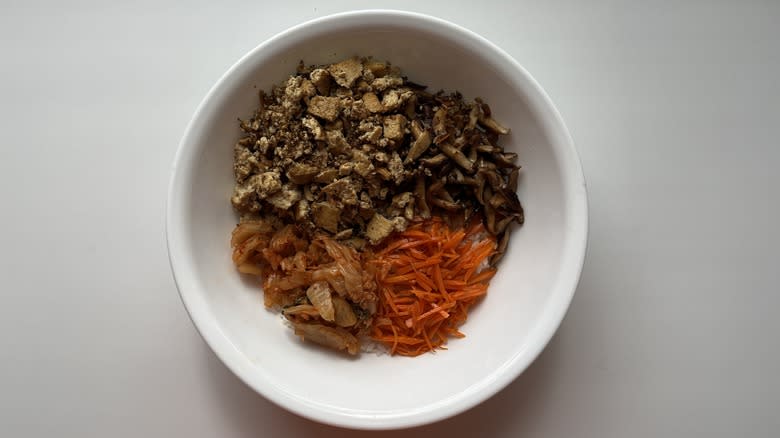
Transfer tofu mixture, along with chopped kimchi and remaining 1 teaspoon salt, to the bowl with the rice.
Step 15: Mix Up The Filling
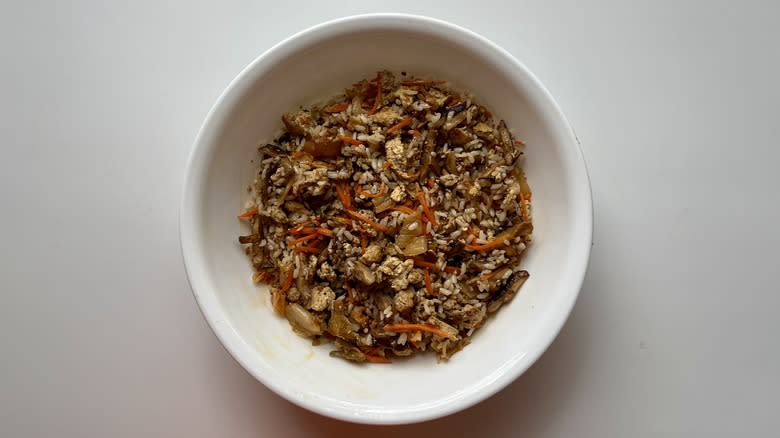
Stir to combine.
Step 16: Stuff Each Pepper And Top It With An Egg
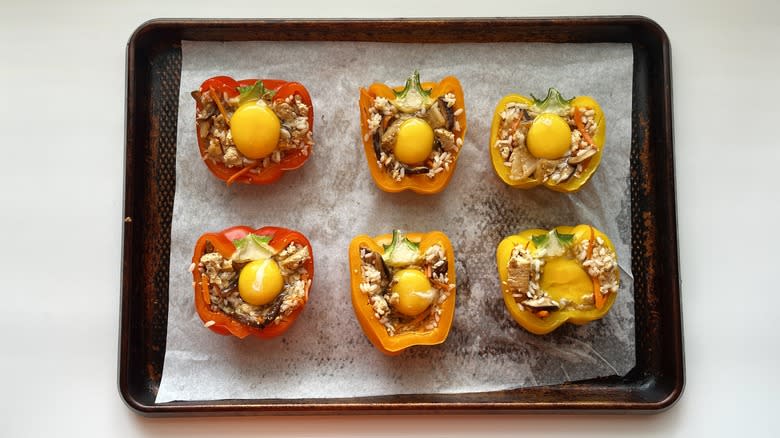
Divide filling evenly among the peppers, then make a well in the filling and crack an egg into each.
Step 17: Bake The Peppers
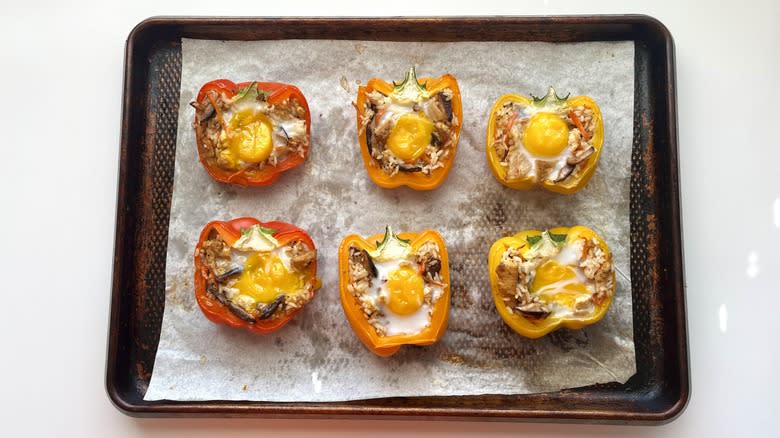
Bake for 15-20 minutes, until eggs are cooked but still runny in the yolk.
Step 18: Combine The Ingredients For The Sauce
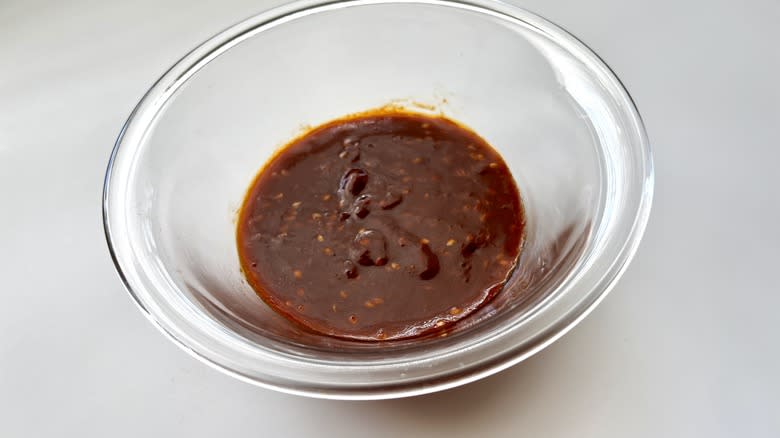
Meanwhile, make the bibimbap sauce by whisking together the gochujang, sesame oil, soy sauce, rice vinegar, garlic, and sesame seeds.
Step 19: Pour The Sauce Over The Cooked Peppers
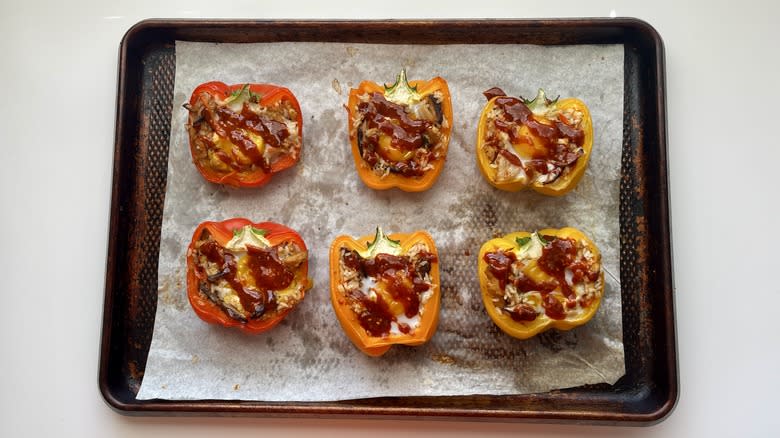
Once peppers are done, drizzle bibimbap sauce all over.
Step 20: Garnish And Enjoy
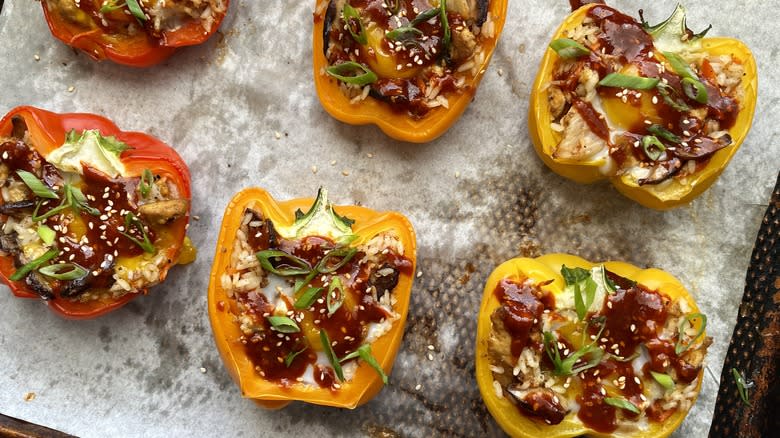
Garnish with sliced scallions and extra sesame seeds, and serve with extra bibimbap sauce on the side.
How Can I Switch Up This Tofu And Kimchi Bibimbap-Stuffed Pepper Recipe?
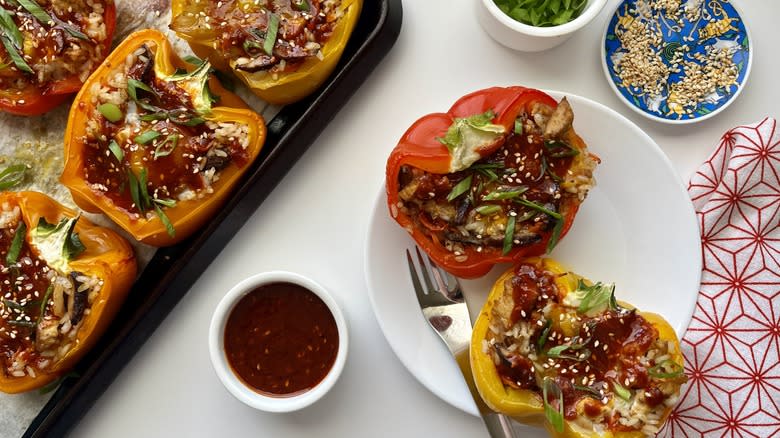
While this recipe makes a hearty vegetarian entree (or even a vegan one if you leave out the egg), you could always add more vegetables to bulk it up or go in the opposite direction and make it meaty. As Le Moing points out, traditional bibimbap is made with ground beef and also includes zucchini, bean sprouts, and spinach in addition to the mushrooms and carrots. "Feel free to mix and match as you please," she says, and that applies to the seasoning, as well — you're welcome to dial the amount of gochujang up or down as you prefer.
Yet another change you can make to this recipe is to roast the bell peppers in the oven for about 10 minutes at 400 F, but remember that they'll be cooked once again after they've been stuffed. If you opt to bake the peppers instead of boiling them, you can either use a rice cooker for the rice or steam it on the stovetop.
What Can I Do With Leftover Tofu And Kimchi Bibimbap-Stuffed Peppers?
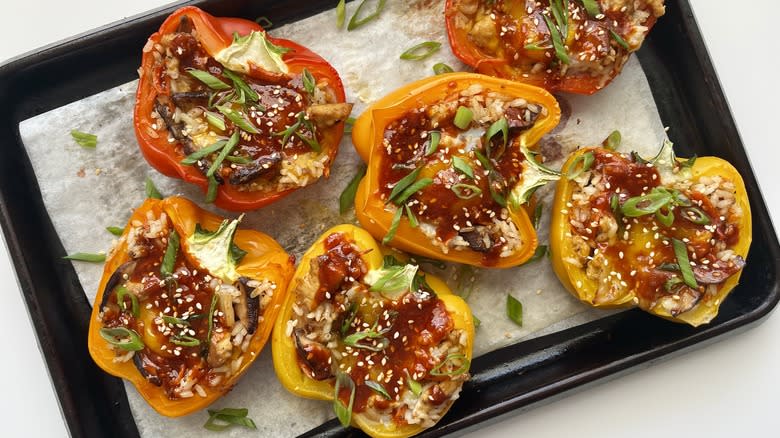
Since this recipe makes half a dozen stuffed peppers, you may have a few left over. Le Moing says you can go ahead and pack them up in a storage tub and keep them in the refrigerator for up to 5 days.
If you know ahead of time that you won't be able to eat all of the peppers in one meal, though, Le Moing recommends that you make one change to the recipe. "Only crack eggs in the peppers that you plan to eat that night," she tells us, explaining: "The eggs don't reheat well." You can go ahead and bake the stuffed peppers without the eggs, then refrigerate them until needed. Once you're ready to eat, either crack an egg into the pepper and bake it until the egg sets, or else fry it in a pan and plop it on top of a pepper that you've reheated in the microwave.
Tofu And Kimchi Bibimbap-Stuffed Pepper Recipe
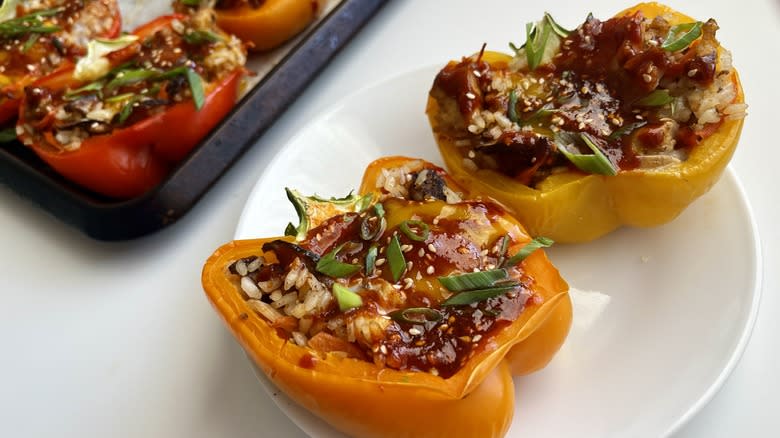
Prep Time: 20mCook Time: 45mYield: 6 servingsIngredients
:::For the stuffed peppers:::
3 large bell peppers (any color)
2 ½ teaspoons kosher salt, divided
¾ cup short-grain rice
3 tablespoons canola oil, divided
¼ cup julienned carrot
5 ounces shiitake mushrooms, sliced
2 cloves garlic, minced
1 teaspoon soy sauce
1 (7-ounce) package baked tofu
½ cup kimchi, chopped
6 medium eggs
3 scallions (green parts only), thinly sliced, for garnish
:::For the bibimbap sauce:::
3 tablespoons gochujang
1 tablespoon toasted sesame oil
1 tablespoon soy sauce
1 teaspoon rice vinegar
1 clove garlic, grated
1 teaspoon toasted sesame seeds, plus more for serving
Directions
Preheat oven to 350 F.
Cut bell peppers in half lengthwise and remove the seeds and membranes.
Add 2 quarts water and 1 ½ teaspoons salt to a medium pot over high heat, and bring to a boil.
Boil peppers in batches until they begin to soften, about 3-4 minutes.
Using tongs or a slotted spoon, remove peppers from the pot, shake off any excess water, and place cut-side up on a parchment-lined baking sheet.
Return water to a boil. Add rice and cook, stirring occasionally, until tender, about 12 minutes.
Drain rice, transfer to a large bowl, and set aside.
Place a 12-inch, heavy-bottomed skillet over medium heat. Once hot, add 1 tablespoon oil and swirl to coat.
Add carrots and cook, stirring often, until they begin to soften, about 4 minutes.
Transfer carrots to the bowl with the rice.
Add 1 more tablespoon oil, along with the mushrooms and garlic, and cook, stirring often, until they begin to soften, about 5 minutes. Stir in the soy sauce.
Transfer mushroom mixture to the bowl with the rice.
Add remaining 1 tablespoon oil to the pan, crumble in the tofu, and saute until lightly browned and warmed through.
Transfer tofu mixture, along with chopped kimchi and remaining 1 teaspoon salt, to the bowl with the rice.
Stir to combine.
Divide filling evenly among the peppers, then make a well in the filling and crack an egg into each.
Bake for 15-20 minutes, until eggs are cooked but still runny in the yolk.
Meanwhile, make the bibimbap sauce by whisking together the gochujang, sesame oil, soy sauce, rice vinegar, garlic, and sesame seeds.
Once peppers are done, drizzle bibimbap sauce all over.
Garnish with sliced scallions and extra sesame seeds, and serve with extra bibimbap sauce on the side.
Read the original article on Tasting Table

 Yahoo Movies
Yahoo Movies 
